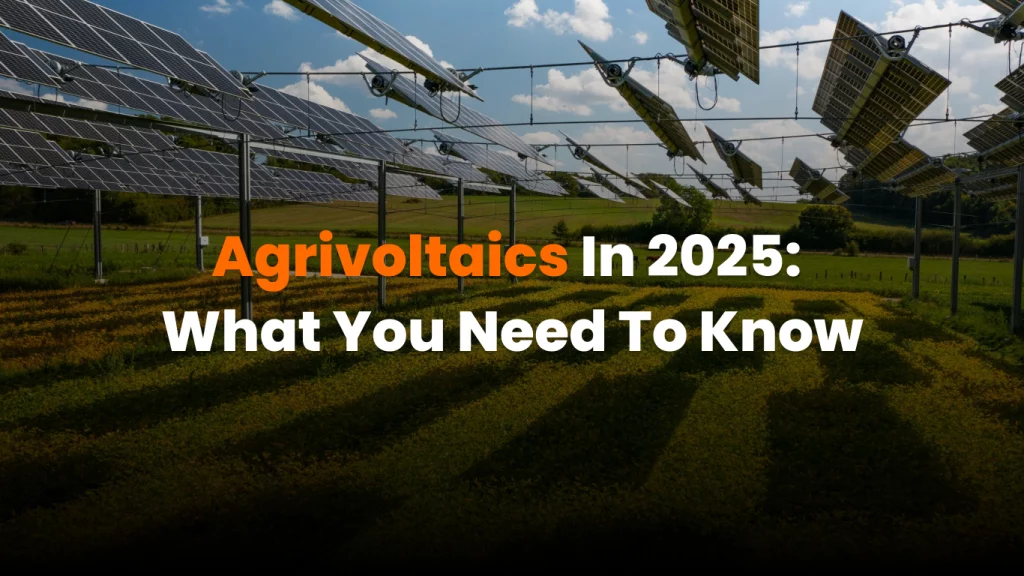Agrivoltaics is no longer just an emerging innovation, it is fast becoming a mainstream pillar of climate-smart agriculture and distributed solar development. As land constraints, energy demand, and climate variability intersect more urgently than ever, agrivoltaics (Agri‑PV) offers an adaptable, future-ready solution that maximizes the use of agricultural land for both food and electricity.
In this follow-up to our original article, we dive deeper into how Agri‑PV is evolving in 2025, from global adoption data to new research on crop compatibility, financing innovations, and digital agriculture tools that are enabling large-scale deployment.
Global adoption: Agrivoltaics surpasses 18 GW worldwide
The global Agri‑PV market grew from 14 GW in 2024 to an estimated 18.4 GW by mid-2025, according to recent updates from SolarPower Europe and PV Magazine. While much of this growth stems from pilot expansions, more countries are beginning to approve commercial-scale Agri‑PV installations, especially in Southern Europe, East Asia, and select U.S. states.
Deployment momentum by region:
- Italy launched a €1.7 billion program to fund 2 GW of Agri‑PV through its National Recovery and Resilience Plan.
- South Korea passed a new Agri‑PV ordinance allowing rice paddies and orchard farms to install PV without land-use conversion penalties.
- India added over 600 MW of Agri‑PV through its KUSUM scheme, targeting solarization of pumps and fallow land.
In the U.S., while Agri‑PV still represents less than 1% of total solar, there are signs of accelerated interest. In Q2 2025, California passed legislation approving dual-use solar zoning for over 20,000 acres of farmland in the Central Valley, marking a significant policy shift.
Research spotlight: Beyond leafy greens
Much early research on agrivoltaics focused on shallow-rooted crops like lettuce and spinach. But recent field trials are expanding the crop spectrum:
- A 2024 MIT-Lincoln Lab study found that chili peppers, strawberries, and eggplant showed yield gains of up to 17% under 35% PV shading.
- Corn and soybeans, long considered marginal under Agri‑PV, showed promising results in high-clearance vertical PV systems, with yield reductions of less than 3% while improving water retention.
- Pollinator habitats and native grasses under fixed-tilt PV structures are now widely accepted, providing both ecological and maintenance benefits.
An emerging best practice is tailoring panel orientation and height to the photosynthetic light saturation point (LSP) of each crop. Data shows that partial shade can actually reduce thermal stress and evapotranspiration, boosting resilience during heatwaves.
Digital tools & AI driving scale
Scaling Agri‑PV requires more than land and panels—it needs intelligent design. In 2025, digital agriculture tools are beginning to bridge this gap:
- AI-optimized panel placement now accounts for seasonal solar angles, crop photoperiodism, and terrain models. Startups like SunAgroTech and AgroSolvers are integrating NDVI (Normalized Difference Vegetation Index) data into panel layout simulations.
- Drone-based multispectral imaging is being used to monitor chlorophyll levels and plant health beneath panels, enabling real-time feedback on light stress and irrigation needs.
- IoT-enabled irrigation systems, paired with shade analysis, have cut water use by up to 35% in trial farms in Spain and Arizona.
These tools allow developers and farmers to co-design systems that meet both yield and energy output KPIs—removing the guesswork from dual-use agriculture.
Financing models that work
One of the major barriers to Agri‑PV adoption remains cost. Raised or tracking PV structures adds 20–40% to capital expenditures, and many farmers lack upfront funds. However, 2025 has seen a wave of innovative financing models:
- Performance-linked incentives: In France, the CRE (Energy Regulation Commission) has introduced a pilot where subsidies scale with both kWh output and documented crop yield improvements.
- Green agritech bonds: Agri‑PV projects in India and Italy are raising capital through green bond issuances, backed by ESG funds and institutional investors.
- Crop-sharing power purchase agreements (PPAs): In Colorado and Japan, developers are piloting contracts where farmers receive lower lease rates in exchange for a percentage of clean energy revenues.
These models distribute risk more equitably and make Agri‑PV more accessible to small and mid-sized farms.
Policy frameworks: The tipping point
Policy continues to play a decisive role in Agri‑PV scalability. While Europe leads with coherent frameworks, 2025 marks a shift in North America and Asia:
- The European Union launched a new Agri‑PV certification scheme under the Common Agricultural Policy (CAP), giving dual-use farms access to both energy and agri-subsidies.
- China’s Ministry of Agriculture added Agri‑PV to its 5-year rural electrification roadmap, setting aside 10 GW of capacity by 2030.
- In the U.S., new USDA and DOE collaboration grants were announced in July 2025 to test Agri‑PV on conservation and tribal lands.
Standardizing land-use rules, water rights, and crop coverage metrics will be key in translating pilot success into mass deployment.
Outlook: Commercial Agri‑PV portfolios on the rise
With improved crop data, financing, and policy, developers are now bundling Agri‑PV into commercial portfolios. This shift mirrors the early solar boom of the 2010s, when residential PV went from boutique to bankable.
- BayWa r.e., NextEra Energy, and Engie are reportedly including Agri‑PV in their 2026 pipeline projections.
- A new market segment is forming around Agri‑PV leasing cooperatives, where rural communities co-own both land and solar assets—blending energy equity with local economic development.
Conclusion
Agrivoltaics in 2025 is entering a new era of scaled implementation. No longer confined to R&D labs or university fields, it is becoming a practical tool for building agricultural resilience, optimizing land use, and accelerating the energy transition.
For stakeholders, from farmers and solar developers to policymakers and financiers, the next 12–24 months will be critical. With the right incentives and innovations, Agri‑PV is poised to move from possibility to portfolio.
References
- SolarPower Europe. Agrivoltaics Report 2025. https://www.solarpowereurope.org
- PV Magazine. “Agri-PV expansion driven by AI and policy reform.” June 2025.
- arXiv.org. “Recent Advances in Agrivoltaic Modeling and Crop Shading Studies.” 2024–2025.
- SolarPlace. “Agri‑PV Investment Trends and Tech Innovations.” Q2 2025 Market Brief.
- Nature Sustainability. “Dual-Use Farming Improves Water Use and Crop Resilience.”
- Solar Builder Magazine. “Smart Irrigation and Drone Monitoring in Agri‑PV Projects.” April 2025.




